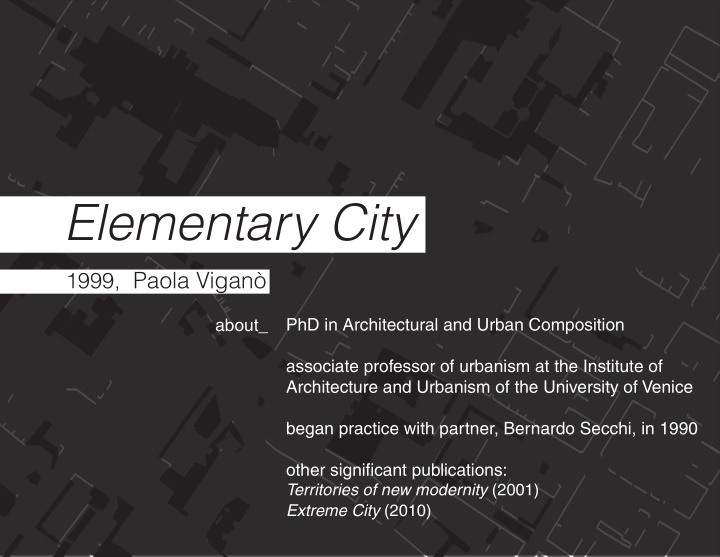



Elementary City 1999, Paola Viganò PhD in Architectural and Urban Composition about_ associate professor of urbanism at the Institute of Architecture and Urbanism of the University of Venice began practice with partner, Bernardo Secchi, in 1990 other signifjcant publications: Territories of new modernity (2001) Extreme City (2010)
elementarism Vigano adapts elementarism for architecture and urbanism from the work and writings of artist, Theo Van Doseberg: “Elementarism does not propose to arrive at a balanced re- lationship between things: ’Elementarism postulates a non- balanced counter composition as a phenomenon of a time space tension of colour, line or plane, always in opposition to the natural or architectural structure.’” Simultaneous Counter-Composition Theo Van Doseberg 1929
elementarism + urbanism fragment/ detail deconstruction/ composition surveying/ naming urban strata/ traces complex/ simple urban materials
fragment_detail proposition of studying urbanism frequently meditates upon heterogeneity and discontinuity cities exist in a condition of fragmentation the city can be considered to be a sequence of urban fragments in the sense that serial music can be considered to be a sequence of tonal fragments the fragmentation of the modern city occurs randomly; though repeated, fjnite elements maintain their interrelation. elementarism requires oscillating analysis of two scales: the urban fragment and the detail
deconstruction_composition deconstruction as tool of elementarian analysis elementarism in urbanism is a process of survey that entails extremely close reading of the city deconstructing the banal, everyday and obvious landscape into the most fundamental of elements the city is illuminated as a place of difference and repetition
surveying_naming strategies of looking at the contemporary city that invest it with new possibilities for interpretation walking: form of deconstructing; naming objects and “breaking down the city into its elements” synecdoche - reduces and densifjes the city asyndeton - fragments the whole urban territory- practices, culture, ‘materiality’
urban strata_traces stratigraphy- analysis of layers which build up over time to produce strata that are indicative of the conditions which created their deposition fragments within a given urban context may appear to lack relation however analysis of urban stratifjcation reveals hidden relationships “the degrees of consistency are only revealed insofar as they are taken apart”
simple_complex materials simple materials- buildings, streets, paths, trees, sporting grounds, etc complex materials- path w/ trees, sports complex, street w/ drain, etc material analysis syntagmatic- function paradigmatic substance, construction urban grammar and syntax - create place by defjning a framework in which segments of urban materials and fragments can occur in sequences . systems- ensembles of urban fragments and segments connected by repeating features
Recommend
More recommend